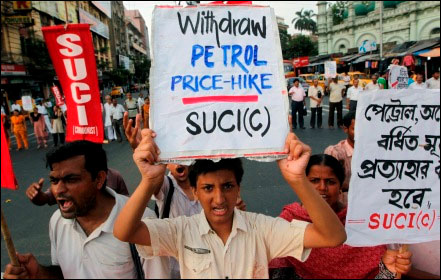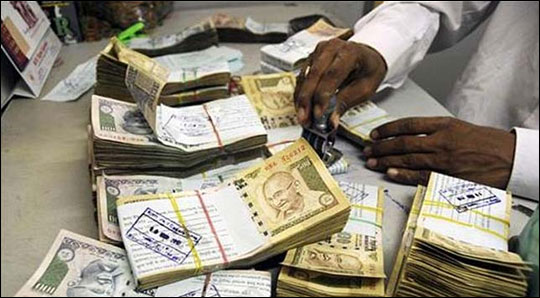Photographs: Reuters Vivek Kaul
A higher government borrowing will 'crowd-out' the private borrowing and push interest rates higher.
The petrol prices were raised by Rs 6.28 per litre on May 23. With taxes the total comes to Rs 7.54 per litre. Let's try and understand what impact this increase in prices will have.
The primary beneficiary of this increase will be the oil marketing companies like Indian Oil, Bharat Petroleum and Hindustan Petroleum. The companies had been losing Rs 6.28 per litre of petrol they sold. Since December, when prices were last raised the companies had lost $830 million in total. With the increase in prices the companies will not lose money when they sell petrol.
The increase in price will have no impact on the fiscal deficit of the government. The fiscal deficit is the difference between what the government spends and what it earns. The government does not subsidize the oil marketing companies for the losses they make on selling petrol.
It subsidises them for losses made on selling diesel, kerosene and LPG, below cost.
Click on NEXT for more...
Higher oil prices or higher EMIs? Take your pick
Photographs: Reuters
The losses on account of this currently run at Rs 512 crore (Rs 5.12 billion) a day. The loss last year to these companies because of selling diesel, kerosene and LPG below cost was Rs 138,541 crore (Rs 1,385.41 billion).
They were compensated for this loss by the government. Out of this the government got the oil and gas producing companies like ONGC, Oil India Ltd and GAIL to pick up a tab of Rs 55,000 crore (Rs 550 billion). The remaining Rs 83,000 odd crore (Rs 830 billion) came from the coffers of the government.
What is interesting is that when the budget was presented in March, the oil subsidy bill for the year 2011-2012 (from April 1, 2011 to March 31,2012) was expected to be at around Rs 68,500 crore (Rs 685 billion). The final number was Rs 14,500 crore (Rs 145 billion) higher.
The losses for this financial year (from April 1, 2012 to March 31,2012) are expected to be at Rs 193,880 crore (Rs 1,938.8 billion). If the losses are divided between the government and the oil and gas producing companies in the same ratio as last year, then the government will have to compensate the oil marketing companies with around Rs 1,14,000 crore (Rs 1,140 billion). The remaining money will come from the oil and gas producing companies.
Click on NEXT for more...
Higher oil prices or higher EMIs? Take your pick
Photographs: Reuters
The trouble is in two fronts. It will pull down the earnings of the oil and gas producing companies. But that's the smaller problem. The bigger problem is it will push up the fiscal deficit. If we look at the assumptions made in the budget for the current financial year, the oil subsidies have been assumed at Rs Rs 43,580 crore (Rs 435.8 billion).
If the government has to compensate the oil marketing companies to the extent of Rs 1,14,000 crore (Rs 1,140 billion), it means that the fiscal deficit will be pushed up by around Rs 70,000 crore more (Rs 1,14,000 crore minus Rs 43,580 crore), assuming all other expenses remain the same.
A higher fiscal deficit would mean that the government would have to borrow more. A higher government borrowing will 'crowd-out' the private borrowing and push interest rates higher. This would mean higher equated monthly installments(EMIs) for people who have loans to pay off or are even thinking of borrowing.
Click on NEXT for more...
Higher oil prices or higher EMIs? Take your pick
Photographs: Reuters
The only way of bringing down the interest rates is to bring down the fiscal deficit. The fiscal deficit target for the financial year 2012-2013 has been set at Rs 5,13,590 crore (Rs 5,135.9 billion).
The government raises this money from the financial system by issuing bonds which pay interest and mature at various points of time. Of this amount that the government will raise, it will spend Rs 3,19,759 crore (Rs 3,197.59 billion) to pay interest on the debt that it already has.
Rs 1,24,302 crore (Rs 1,243.02 billion) will be spent to payback the debt that was raised in the previous years and matures during the course of the year 2012-2013. Hence a total of Rs 4,44,061 crore (Rs 4,440.61 billion) or a whopping 86.5% of the fiscal deficit will be spent in paying interest on and paying off previously issued debt. This is an expenditure that cannot be done away with.
The other major expenditure for the government during the course of the year are subsidies. The total cost of subsidies during the course of this year has been estimated to be at Rs Rs 1,90,015 crore (Rs 1,900.15 billion).
The subsidies are basically of three kinds: oil, food and petroleum. The food subsidy is at Rs 75,000 crore (Rs 750 billion). This is a favourite with Sonia Gandhi and hence cannot be lowered. And more than that there is a humanitarian angle to it as well.
Click on NEXT for more...
Higher oil prices or higher EMIs? Take your pick
Photographs: Reuters
The fertiliser subsidies have been estimated at Rs 60,974 crore (Rs 609.74 billion). This is a political hot potato and any attempts to cut this in the past have been unsuccessful and have had to be rolled back.
There are other subsidies amounting to Rs 10,461 crore (Rs 104.61 billion) which are minuscule in comparison to the numbers we are talking about.
This leaves us with oil subsidies which have been estimated to be at Rs 43,580 crore (Rs 435.8 billion). This as we see will be overshot by a huge level, if oil prices continue to be current levels. Even if prices fall a little, the subsidy will not come down by much.
Hence if the government has to even maintain its deficit (forget bringing it down) the only way out currently is to increase the price of diesel, LPG and kerosene.
Click on NEXT for more...
Higher oil prices or higher EMIs? Take your pick
Photographs: Reuters
Diesel is a transport fuel and an increase in its price will push prices inflation in the short term. But maintain the fiscal deficit will at least keep interest rates at their current levels and not push them up from their already high levels.
If the government continues to subsidize diesel, LPG and kerosene, interest rates are bound to go up because it will have to borrow more. This will mean higher EMIs for sure. It would also mean businesses postponing expansion because higher interest rates would mean that projects may not be financially viable.
It would also mean people borrowing lesser to buy homes, cars and other things, leading to a further slowdown in a lot of sectors. In turn it would mean lower economic growth.
That's the choice the government has to make. Does it want the citizens of this country to pay higher fuel and gas prices? Or does it want them to pay higher EMIs? There is no way of providing both.
Vivek Kaul is a writer and can be reached at vivek.kaul@gmail.com







article